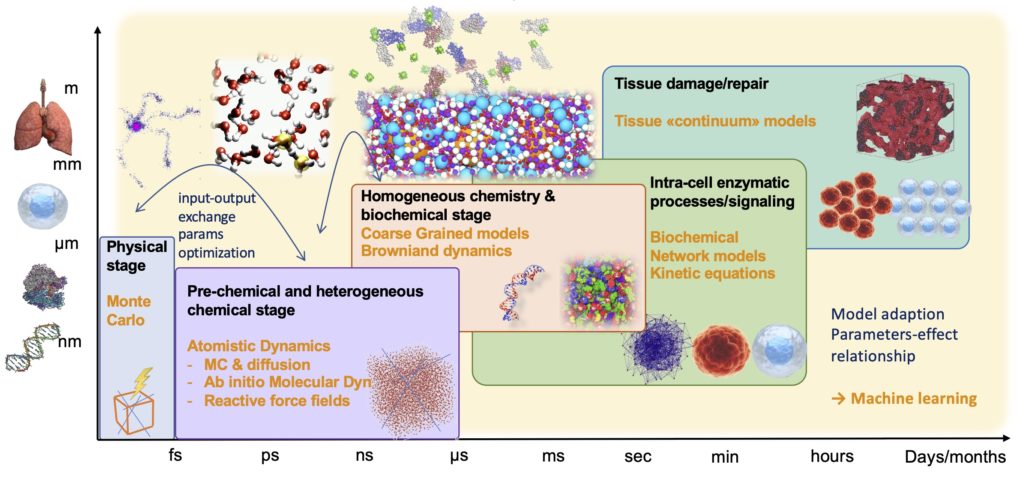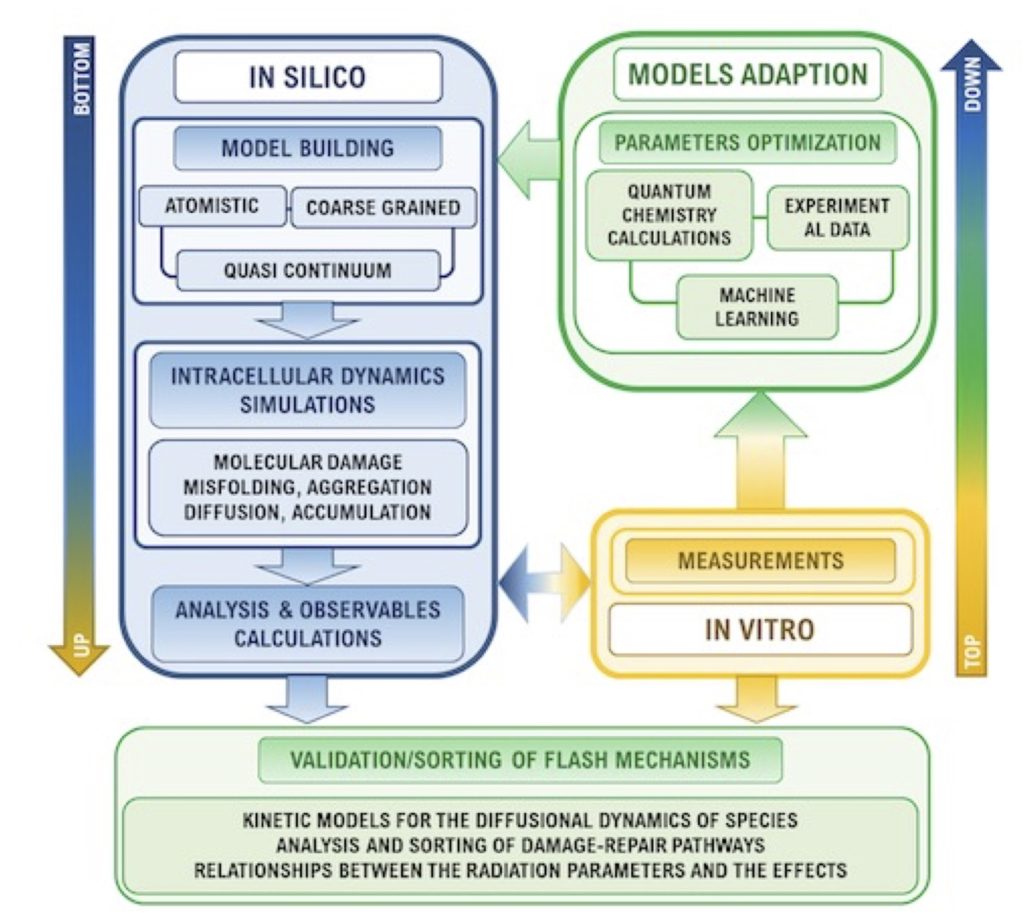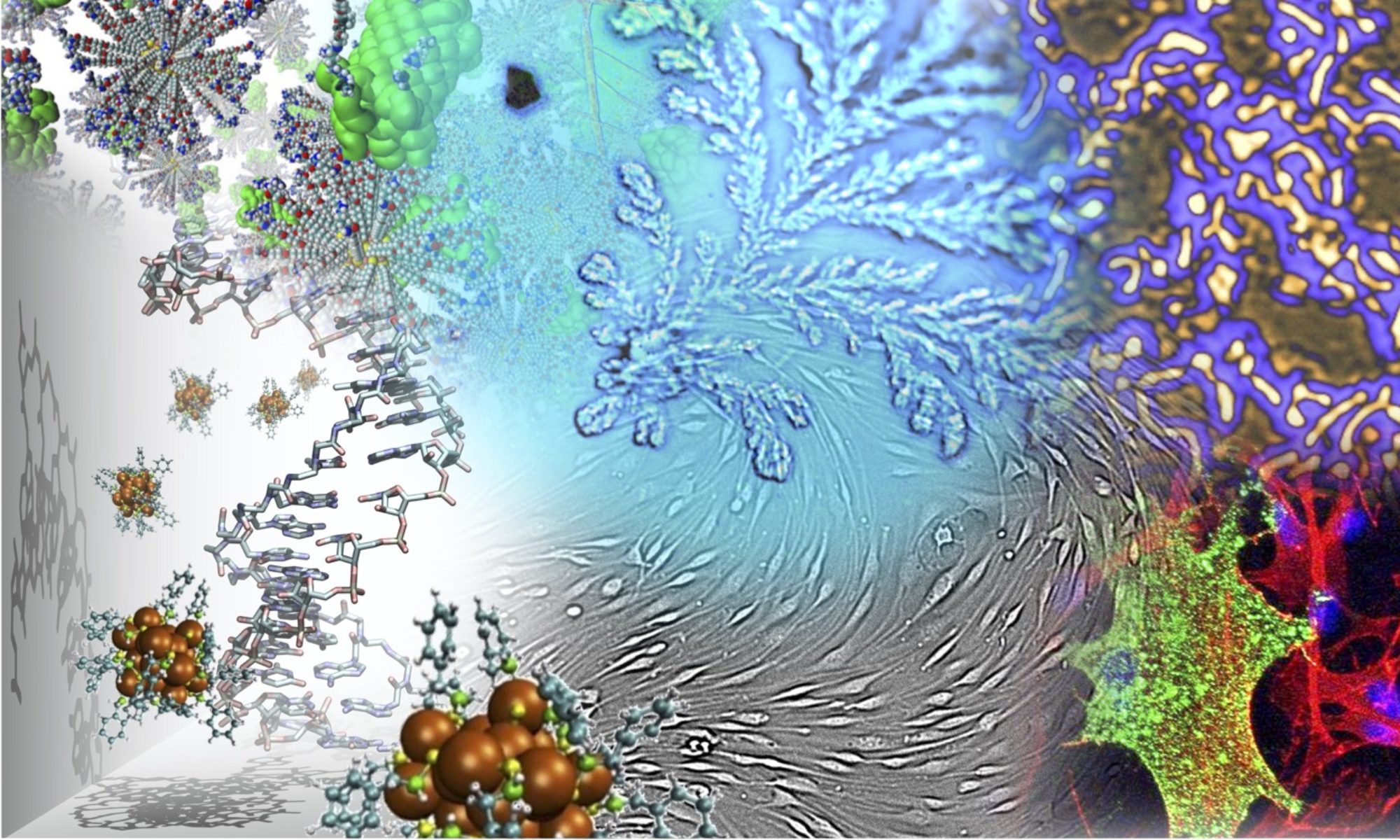Radiotherapy is one of the most powerful weapons against cancer, with the main drawback of toxicity for the normal tissues. In the last decade, evidences were established that ultra-high dose rate (UHDR) radiations delivered for very short times by pulsed beams can selectively spare normal tissues while keeping efficacy on the cancerous ones, named the FLASH-effect. While the clinical translation of this potentially disruptive new radiotherapy technique is currently in the experimental phase, the underlying cellular mechanism of the differential effects in cancer vs normal tissues and FLASH-vs-conventional RT are not understood. A number of different hypotheses is currently under investigation involving one or more effects among the differential radiation-induced radicals production/depletion, cell-specific differences in the detoxify/recover pathways, different intra/inter cellular diffusion of toxic substances or recovery signaling, and others. These processes involve a cascade of events spaning ~12 orders of magnitudes in size and ~15 in time.


In silico (computer) modeling could clarify the connections between the physical parameters of the radiation and the radiobiological effects measured in vitro and in vivo. Clearly, however, modeling such a variety of phenomena requires a formidable concerted effort involving a number of different simulation techniques and methods, namely a multi-scale modeling approach. Up to now, atomistic molecular dynamics (MD) simulations were combined with Monte Carlo (MC) ones and kinetic models to explore the physical and chemical phases, and the macroscopic differential effects at the cellular /tissue level was analyzed with models mainly relying on graph representation of the biochemical networks. The effects at the intermediate (sub)cellular level has been explored combining MC with coarse grained models mainly focusing on DNA damage.
Within the newly started THE-Advanced radiotherapies and diagnostic in oncology, we aim to realize the full multi-scale representation of the radiobiological effects, with a particular focus on the (sub)cellular level, using coarse grained representation of the biomolecules within the cytoplasm. We will design and implement algorithms and interfaces between software tools and achieve the coherency among levels by extracting, exchanging input/outputs data and optimizing model parameters with the aid of machine learning algorithms. With this approach, we will analyze the radiation damage and different recovery pathways in models for healthy and cancer tissues, and with different irradiation modality. A a call for a research scientist position on these themes is currently open. Please look at the flyer for further information or email to valentina.tozzini@nano.cnr.it.
| People | Melissa Santi, ValentinaTozzini* |
| Keywords | FLASH radiotherapy, molecular radiobiological effects, precision oncology |
| Methods, techniques | Multi-scale modeling, ab initio molecular dynamics, classical molecular dynamics, coarse grained models, Monte Carlo Simulations |
| Collaborations | Centro Pisano Multidisciplinare sulla Ricerca e Implementazione Clinica della Flash Radiotherapy (CPFR, co-funded by Fondazione Pisa), which includes UniPi-CISUP (S Capaccioli), UniPi (Fabiola Paiar, scientific director and Aldo Paolicchi), AOUP (Fabio Di Martino, technical director), CNR-IN (Mario Costa) and INFN-Pi (MG Bisogni), and with INFN-TIFPA (E Scifoni), SIT Sordina IORT Technologies (G Felici), Susanna Monti ICCOM- CNR Pisa |
| Projects | 2022-2025: Tuscany Health Ecosystem – Spoke 1: Advanced Radiotherapies and Diagnostics in Oncology, PNRR, Next generation EU |
| Seminars | V Tozzini Multi-scale modeling of irradiation induced effects TIFPA-INFN, Dept of Physics Trento University. Host Dr Emanuele Scifoni (2023) |
| Publications | |
| L Castelli, G Camazzola, M C Fuss, D Boscolo, M Kraemer, V Tozzini, M Durante, E Scifoni Probing spatiotemporal effects of intertrack recombination with a new implementation of simultaneous multiple tracks in TRAX-CHEM Int J Mol Sci (2025 | |
| F Di Martino, E Scifoni, V Patera, P Montay-Gruel, F Romano, A Darafsheh, V Tozzini Editorial: Multidisciplinary approaches to the FLASH radiotherapy Front Phys 2024 | |
| V Tozzini, L Castelli, E Scifoni, S Monti, L. Petrolli A multi-scale approach to the FLASH effect modeling Physica Medica 2023 | |
| F Del Debbio, M S Bertilacchi, A Gonnelli, E Da Pozzo, V Tozzini, C Martini, S Capaccioli, B Costa An insight into hypothesised biological mechanisms contributing to the Flash effect Front Phys 2023 | |
| G Palermo, AMJJ Bonvin, M Dal Peraro, RE Amaro, V Tozzini Multiscale Modeling from Macromolecules to Cell: Opportunities and Challenges of Biomolecular Simulations Front Mol Biosci 2020 | |
| G Brancolini, V Tozzini Multi-scale modeling of Proteins interactions with functionalized Nanoparticles Curr Opin Coll Int Sci 2019 | |
| F Trovato, V Tozzini Diffusion within the cytoplasm: a mesoscale model of interacting macromolecules Biophys J 2014 | |
| V Tozzini Multiscale modeling of proteins Acc Chem Res 2010 | |
| K Voltz, J Trylska, V Tozzini, V Kurkal‐Siebert, J Langowski, J Smith Coarse‐grained force field for the nucleosome from self‐consistent multiscaling J Comp Chem 2008 |

